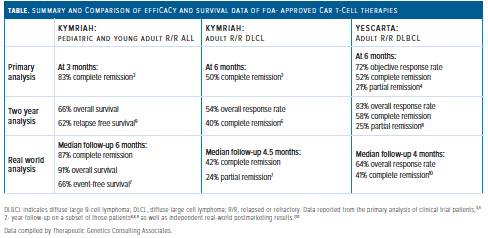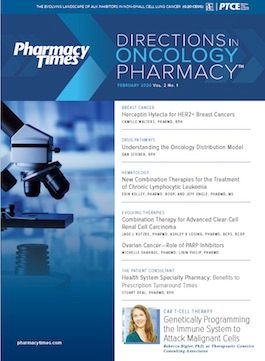Publication
Article
Pharmacy Practice in Focus: Oncology
CAR T-Cell Therapy: Genetically Programming the Immune System to Attack Malignant Cells
Author(s):
Current FDA-approved CAR-T cell therapies express CARs recognizing CD19, which is expressed on the surface of almost all B cells, making these therapies specific for B-cell malignancies.
WHEN THE CONCEPT of harnessing the immune system to attack cancer was proposed in the mid-1950s, the structure of DNA had just been published, and single-cell organisms were the only cells that could be genetically manipulated.1,2 This once futuristic idea is now a clinical reality.
T cells and B cells are 2 primary cell types in our adaptive immune system, the source of immunological “memory” protecting us from subsequent pathogen exposure. B cells secrete pathogen-specific antibodies, which neutralize pathogens directly, or tag them for attack by other immune cells. T cells destroy pathogenic cells directly as well as secrete cytokines to attract additional immune cells.
Chimeric antigen receptor (CAR) T cells are patient derived T cells genetically manipulated to express an artificial transmembrane receptor. The artificial receptor is engineered from modular parts to bind to a surface protein (also called an antigen) on malignant cells and activate the T cell via engineered T cell signaling switches on the CAR.
Current FDA-approved CAR-T cell therapies express CARs recognizing CD19, which is expressed on the surface of almost all B cells, making these therapies specific for B-cell malignancies. Following binding with a CD19-expressing cell, the CAR T cell is activated to proliferate, eliminate the CD19-expressing cell, and persist within the patient.
Tisagenlecleucel (Kymriah, Novartis) is approved to treat pediatric and young adult patients (up to age 25) with relapsed or refractory (R/R) B-cell acute lymphoblastic leukemia (R/R ALL, ELIANA trial) and adult patients with R/R diffuse large B-cell lymphoma (R/R DLBCL, JULIET trial) after 2 or more lines of systemic therapy. Axicabtagene ciloleucel (Yescarta, Kite Pharma) is approved for adult patients with R/R large B-cell lymphoma (R/R DLBCL, ZUMA-1 trial, NCT02348216) after 2 or more lines of systemic therapy. There are approximately 700 new cases of pediatric and young adult R/R ALL annually in the United States. New cases of R/R DLBCL are approximately 7000 annually in the United States.
CARs can be engineered to recognize virtually any cell surface antigen and can be expressed in a variety of immune cells, suggesting that product development will result in many modular CAR units with vast application versatility. Many different antigen and cell type combinations are already currently in development to address several cancers, such as CAR T cells for pancreatic cancer (NCT03323944).
The first step in creating these personalized genemodified cell therapies is collecting patient lymphocytes via leukapheresis at a clinic or infusion center. Lymphocytes include T cells, B cells, and natural killer cells. The leukapheresis process lasts up to 4 hours and must be coordinated with the patient’s continuing care regimen to ensure sufficient T cells. The lymphocytes are cryopreserved and immediately shipped to a centralized manufacturing facility.
T cells are separated from the other cells in the leukapheresis product and genetically manipulated, typically using a lentiviral gene delivery method to carry DNA encoding the CAR protein, resulting in CAR T cells. The CAR T cells are cultured to a patient-specific appropriate dose. As this process is finishing, the manufacturer coordinates with the patient’s health care team to ensure the patient and team are prepared to infuse the CAR T cells. The manufacturing process from the apheresis process to the clinical CAR-T cell product varies widely from patient to patient, from 14 days up to a few months. The limiting step is typically reaching the appropriate CAR-T cell dose.
About a week before the scheduled CAR-T cell infusion, the patient receives multiple days of low-dose conditioning chemotherapy. This step serves to deplete lymphocytes before administration of the CAR T cells, improving the efficacy and persistence of therapy. The CAR T cells are then administered intravenously, and the patient is monitored for adverse events (AEs). The most common AEs with both currently approved products include cytokine release syndrome (CRS), neurological toxicity (NT), hypersensitivity reactions, serious infection, prolonged cytopenias, and hypogammaglobulinemia.3,4 Both products caution that therapy could cause hepatitis B viral reactivation.
The most severe reactions are CRS and NT, both of which can be life threatening. CRS, a common immune reaction following infusion of monoclonal antibodies and CAR T cells, is characterized by fever, nausea, chills, hypotension, tachycardia, asthenia, headache, rash, and dyspnea.5 Mild cases are easily managed, whereas severe cases require more aggressive and invasive therapy, such as mechanical ventilation and intravenous administration of tocilizumab. NT associated with CAR-T cell therapy is characterized by encephalopathy, headache, aphasia, delirium, insomnia, anxiety, tremor, dizziness, seizures, and peripheral neuropathy.
During the clinical trials of Kymriah and Yescarta, CRS and NT occurred in most patients with more than 10% experiencing severe CRS and more than 20% with severe NT.3,4 Initially, the 2 AEs appeared to be independent, but data are beginning to emerge suggesting a correlation. CRS might be a predictor of neurological events; however, neurological events do not predict CRS.6
Real-world evidence from patients treated with Kymriah, presented at the 2019 Society of Hematologic Oncology annual meeting, reported that slightly more than half experienced either of these conditions and less than 20% had severe cases.7 Two-year followup data regarding Yescarta reported severe CRS cases in 11% of patients and severe NT cases in 32%.8 Due to the high rate of occurrence and severity of CRS and NT, both Yescarta and Kymriah have restricted availability through Risk Evaluation and Mitigation Strategies.3,4 Both medications must be administered at a Risk Evaluation and Mitigation Strategies—certified health care facility with health care providers trained in the management and treatment of CRS and 2 doses of tocilizumab available for each patient before CART cell infusion.

Regardless of the potential for severe adverse events (AEs), the benefit of both Yescarta and Kymriah outweigh the risks, as they are highly effective singleadministration therapies. Despite the aggressive nature of the cancers treated with CAR T-cell therapy, meaningful clinical benefit can be achieved within 1 month. A summary of clinical trial primary response rates as well as 2-year data and published real-world data can be found in Table.
Despite differences between the 2 clinically available products, their safety and efficacy profiles in patients with R/R DLBCL are comparable. Differences between the therapies range from the molecular units comprising the CARs, manufacturing differences, lymphodepletion regimen, number of CAR T cells and volume infused, and whether the infusion and short-term patient monitoring occurs in an inpatient or outpatient setting.
Patient-specific genetically modified cell therapies can present many manufacturing challenges. One stark difference between the available therapies, relevant to the patient and clinician experience, has been the manufacturing time and failure rate. During ZUMA-1, of the 101 patients treated with Yescarta, the median time from leukapheresis to product delivery was 17 days (range, 14-51 days), and a 1% manufacture failure rate was reported.4 The ELIANA trial of Kymriah in patients with R/R ALL reported a 9% manufacture failure rate, whereas the JULIET R/R DLBCL trial reported a failure rate of 6.9%, and of the 106 patients receiving Kymriah, the median manufacture time was 113 days (range, 47-196 days).3
Commercial manufacture of Kymriah for DLBCL has struggled to meet specifications.11 While addressing the production issue, Novartis has initiated a safety study evaluating out-of-specification product (NCT04094311) and a managed-access program (NCT03601442).
Known causes of CAR-T cell therapy failure are T cell exhaustion and antigen escape. T cell exhaustion is characterized by a loss of responsive T cells due to changes in gene expression and can be prevented by immune checkpoint inhibitors PD-1, PD-L1, or CTLA- 4. Antigen escape describes a condition in which some cancer cells do not express the CAR-targeted antigen; therefore, they escape immune activation and survive within the patient. Engineering a secondary CAR to a different antigen, such as CD22 in the case of ALL, increases the likelihood of targeting all malignant cells. Solutions to both of these inhibitory mechanisms are currently under clinical trial investigation.12,13
The therapeutic success of CAR T cells ensures gene-modified immune cell therapy will be refined, optimized, and broadly applied until limits are reached. Many clinical groups are investigating biomarkers associated with severe AEs to provide an additional layer of precision care to the CAR-T cell therapy model.6,14 In addition, clinical trials are underway evaluating combination therapies to enhance the efficacy and improve the safety of CART cell therapy. Early-stage research is evaluating the possibility of “off-the-shelf” CAR-T cell therapy, not a patient-unique manufactured product, to reduce the time to treatment and achieve manufacturing efficiencies and consistencies.15,16 Gene-modified cell therapy, such as CAR T-cell therapy, is revolutionizing oncology, and this “living drug” model is breathing life into the hopes of patients with cancer and caregivers.
REBECCA BIGLER, PHD, is chief scientific officer of Therapeutic Genetics Consulting Associates, a Chapel Hill, North Carolina-based firm specializing in closing the knowledge gap between cutting-edge genetic medicine and routine medical and pharmacy care. She also serves on the board of directors of the Specialty Pharmacy Certification Board. She is a member of the American Society of Gene & Cell Therapy and the Clinical Pharmacogenomics Implementation Consortium.
REFERENCES
- Billingham RE, Brent L, Medawar PB. Quantitative studies on tissue transplantation immunity. II. The origin, strength and duration of actively and adoptively acquired immunity. Proc R Soc Lond B Biol Sci. 1954;143(910):58-80. doi:10.1098/rspb.1954.0054
- Mitchison NA. Studies on the Immunological Response to Foreign Tumor Transplants in the Mouse. J Exp Med. 1955;102(2):157-177.
- KYMRIAH (tisagenlecleucel). FDA. April 2019. http://www.fda.gov/vaccines-blood-biologics/cellular-gene-therapy-products/kymriah-tisagenlecleucel. Accessed November 10, 2019.
- YESCARTA (axicabtagene ciloleucel). FDA. April 2019. http://www.fda.gov/vaccines-blood-biologics/cellular-gene-therapy-products/yescarta-axicabtagene-ciloleucel. Accessed November 10, 2019.
- Breslin S. Cytokine-release syndrome: overview and nursing implications. Clin J Oncol Nurs. 2007;11(1 Suppl):37-42. doi:10.1188/07.CJON.S1.37-42
- Harris J. Phase II JULIET Study Continues To Show Benefit of Tisagenlecleucel in DLBCL. Targeted Oncology. https://www.targetedonc.com/conference/soho-2019/phase-ii-juliet-study-continues-to-show-benefit-of-tisagenlecleucel-in-dlbcl. Accessed November 10, 2019.
- Harris J. Real-World Data Show Tisagenlecleucel is an Effective Treatment for DLBCL. Targeted Oncology. https://www.targetedonc.com/conference/soho-2019/realworld-data-shows-tisagenlecleucel-is-an-effective-treatment-for-dlbcl. Accessed November 10, 2019.
- Locke FL, Ghobadi A, Jacobson CA, et al. Long-term safety and activity of axicabtagene ciloleucel in refractory large B-cell lymphoma (ZUMA-1): a single-arm, multicentre, phase 1—2 trial. Lancet Oncol. 2019;20(1):31-42. doi:10.1016/S1470-2045(18)30864-7
- Children’s Hospital of Philadelphia. Immunotherapy pioneers reveal updated efficacy data of tisagenlecleucel CAR T-cell therapy. EurekAlert! https://www.eurekalert.org/pub_releases/2018-12/chop-ipr120418.php. Accessed November 10, 2019.
- Jacobson CA, Hunter B, Armand P, et al. Axicabtagene Ciloleucel in the Real World: Outcomes and Predictors of Response, Resistance and Toxicity. Blood. 2018;132(Supplement 1):92-92. doi:10.1182/blood-2018-99-117199
- Pagliarulo N. In CAR-T, manufacturing a hurdle Novartis has yet to clear. BioPharma Dive. https://www.biopharmadive.com/news/in-car-t-manufacturing-a-hurdle-novartis-has-yet-to-clear/543624/. Accessed November 11, 2019.
- Home - ClinicalTrials.gov. https://clinicaltrials.gov/. Accessed November 9, 2019.
- Harris. Expert Suggests Novel Approaches To Improve CAR Therapies in ALL. Targeted Oncology. https://www.targetedonc.com/conference/soho-2019/expert-suggests-novel-approaches-to-improve-car-therapies-in-all. Accessed November 10, 2019.
- Abutalib SA, Levine BL. Update on FDA-Approved CAR T-Cell Products Axicabtagene Ciloleucel - The ASCO Post. https://ascopost.com/issues/february-25-2019/update-on-fda-approved-car-t-cell-products-axicabtagene-ciloleucel/. Accessed November 10, 2019.
- Kawamoto H, Masuda K, Nagano S, Maeda T. Cloning and expansion of antigen-specific T cells using iPS cell technology: development of “off-the-shelf” T cells for the use in allogeneic transfusion settings. Int J Hematol. 2018;107(3):271-277. doi:10.1007/s12185-018-2399-1
- Iriguchi S, Kaneko S. Toward the development of true “off-the-shelf” synthetic T-cell immunotherapy. Cancer Sci. 2019;110(1):16-22. doi:10.1111/cas.13892






